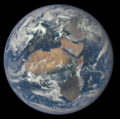File:Africa and Europe from a Million Miles Away.png

Kukura kwe chipandwa ichi: 604 × 600 pixels Zvimwe misimbiro: 242 × 240 pixels | 483 × 480 pixels | 773 × 768 pixels | 1,031 × 1,024 pixels | 1,780 × 1,768 pixels
Fayera repachivambo (1,780 × 1,768 pixels, file size: 3.68 MB, MIME type: image/png)
Nhoroondo ye fayera
Dzvanya pa musi/nguva kuti uringe fayera sekuoneka kwaraita panguva iyoyo.
| Musi/Nguva | Mfananoudoko | Mitandu | Mushandisi | Komenda | |
|---|---|---|---|---|---|
| parizvino | 13:09, 9 Nyamavhuvhu 2015 |  | 1,780 × 1,768 (3.68 MB) | JorisvS | crop; there was too much black |
| 11:44, 8 Nyamavhuvhu 2015 |  | 2,048 × 2,048 (2.98 MB) | ArionStar | Tight crop | |
| 02:56, 31 Chikunguru 2015 |  | 1,700 × 1,700 (3.67 MB) | PhilipTerryGraham | Crop | |
| 17:30, 29 Chikunguru 2015 |  | 2,048 × 2,048 (2.98 MB) | Originalwana | {{Information |Description ={{en|1=Africa is front and center in this image of Earth taken by a NASA camera on the Deep Space Climate Observatory (DSCOVR) satellite. The image, taken July 6 from a vantage point one million miles from Earth, was one... |
Kushandiswa kwe fayera
The following page uses this file:
Kushandiswa kwe fayera pasirose
Mawiki anotevera ayo anoshandisa fayera iri:
- Hushandiso pa af.wikipedia.org
- Hushandiso pa ar.wikipedia.org
- كوكب
- إفريقيا
- ويكيبيديا:صور مختارة/الفضاء والكون/نظرة إلى الخلف
- بوابة:علم الفلك/صورة مختارة
- ويكيبيديا:ترشيحات الصور المختارة/إفريقيا وأوروبا
- ويكيبيديا:صورة اليوم المختارة/سبتمبر 2018
- قالب:صورة اليوم المختارة/2018-09-07
- بوابة:علم الفلك/صورة مختارة/64
- جغرافيا إفريقيا
- ويكيبيديا:صورة اليوم المختارة/فبراير 2020
- قالب:صورة اليوم المختارة/2020-02-29
- ويكيبيديا:صورة اليوم المختارة/ديسمبر 2022
- قالب:صورة اليوم المختارة/2022-12-31
- Hushandiso pa as.wikipedia.org
- Hushandiso pa bcl.wikipedia.org
- Hushandiso pa be-tarask.wikipedia.org
- Hushandiso pa blk.wikipedia.org
- Hushandiso pa ckb.wikipedia.org
- Hushandiso pa crh.wikipedia.org
- Hushandiso pa cv.wikipedia.org
- Hushandiso pa de.wiktionary.org
- Hushandiso pa el.wikipedia.org
- Hushandiso pa el.wiktionary.org
- Hushandiso pa en.wikipedia.org
- List of Solar System objects by size
- Wikipedia:Userboxes/Seasonal
- User:Kwamikagami/sandbox
- Talk:Earth/Archive 14
- User:Kazkaskazkasako/Books/Physical sciences
- User:Rfassbind/sandbox/Leadimage compilations
- Talk:Earth/Archive 15
- User:VGrigas (WMF)/Quality Media
- User:Jmaxx37
- Wikipedia:Wikipedia Signpost/2018-10-28/Gallery
- Wikipedia:Wikipedia Signpost/Single/2018-10-28
- User:Applekle/sandbox
- User:Double sharp/Largest Solar System objects
- User:Maria DDias/TWA/Earth/2
- User:Jmaxx37/Userboxes
- User:Jmaxx37/Userboxes/Fav-holiday Earth Day
- Wikipedia talk:WikiProject Userboxes/New Userboxes/Archive 38
- User:Roger Capybara6
- User:KeroseneLover100/sandbox/sandbox
- Hushandiso pa en.wikiversity.org
- Hushandiso pa eo.wikipedia.org
- Hushandiso pa es.wikipedia.org
Ringa kushandiswa kumwe kwe vupasirose kwe fayera rino.



